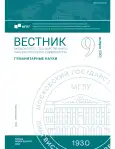GAME TOPONYMY: THE IMPACT OF LOCALIZATION OF CHINESE VIDEO GAMES ON THEIR TRANSLATION
- Authors: Na J.1, Guan X.1, Karabulatova I.S.1,2,3
-
Affiliations:
- Heilongjiang University
- Lomonosov MSU
- Lumumba RUDN-university
- Issue: No 9(890) (2024)
- Pages: 134-142
- Section: Linguistics
- URL: https://journal-vniispk.ru/2542-2197/article/view/297623
- ID: 297623
Cite item
Full Text
Abstract
The authors consider aspects of modern translated video games, understood as a new type of polycode art through the use of achievements in neuroesthetics, history, folklore, cultural studies in virtual game universes and probabilistic forecasting of speech and behavioral profiles of video game users. The study is based on the analysis of translations of toponymic loci in a video game, special attention is paid to the specifics of translation depending on the country in which this game is distributed.
About the authors
Junyuan Na
Heilongjiang University
Author for correspondence.
Email: n3xuss@icloud.com
post-graduate student Institute of Russian Language
ChinaXiujuan Guan
Heilongjiang University
Email: guanshan4500@sina.com
Doctor of Philology (Dr. habil.), Professor, Deputy-director of Institute of Russian Language Heilongjiang University
ChinaIrina Sovetovna Karabulatova
Heilongjiang University;Lomonosov MSU;
Lumumba RUDN-university
Email: radogost2000@mail.ru
Doctor of Philology (Dr. habil.), Professor, Head of Scientifical-Research Center of Digital Humanitarian Technologies Institute of Russian Language Heilongjiang University, Project Manager, leading researcher of laboratory of machine learning and semantic analysis Institute AI Lomonosov Moscow State University, professor of department of foreign languages of Faculty of Philology Lumumba RUDN-university
ChinaReferences
- Chandler, H. M., O’Malley-Deming, S. (2012). The Game Localization Handbook. 2nd ed. Sudbury, MA; Ontario and London: Jones & Bartlett Learning.
- Kharlashkin, M. (2016). Features of discourse of videogames. Bulletin of the Moscow State Regional University, 1, 92–98.
- Wilson, P. (2012). The Video Game Industry: Formation, Present State, and Future: Formation, Present State, and Future. ProQuest Ebook Central: Taylor & Francis Group.
- Khoshsalighen, M., Zoraqi, A. A. (2022). Enhancing Video Games Localization through Dubbing. Translation and Translanguaging in Multilingual Contexts, 8(3), 342–347.
- Bukharova, A. A. (2021). Proper names as precedent nominations within the XYZ construction. Vestnik of Moscow State Linguistic University. Humanities, 9(851), 135–147. doi: 10.52070/2542-2197_2021_9_851_135.
- Włodowska, Z. (2021). Wybrane toponimy w rosyjskim przekładzie gry The Elder Scrolls V: Skyrim. Pattern Recognition, 1(173), 218–232. doi: 10.31261/pr.8957.
- Schweitzer, A. D. (1988). Theory of translation: status, problems, aspects / ed. by V. N. Yartsev; Academy of Sciences of the USSR, Institute of Linguistics. Moscow: Nauka. (In Russ.)
- Merlian, S. E. (2014). Localization as a kind of translation activity. In Communicative aspects of language and Culture (pp. 241–247): Materials of the XIV International Scientific and Practical Conference of Students and Young Scientists. Tomsk: Publishing House of Tomsk Polytechnic University. (In Russ.)
- Pym, A. (2011). The Oxford Handbook of Translation Studies. New York: Oxford University Press Inc.
- Bredikhin, S. N., Leonov, A. A. (2019). Transformation of the concept structure in the process of localization of computer games with elements of the fantasy genre. Actual problems of philology and pedagogical linguistics. 1, 70–76. 10.29025/2079-6021-2019-1-70-76. EDN TISHLZ. (In Russ.)
- 朱璇. 游戏翻译中文化意象的翻译策略[D].北京外国语大学, 2014. Zhu Xuan. (2014). Translation strategies of cultural images in game translation. Beijing Foreign Studies University. (In Chinese)
- Em, T. V., Toizhan, J. N. (2022). Features of the transmission of cultural realities in the localization of video games. In Achievements in Science and education 2022 (pp. 112–114): collection of articles of the II International Scientific Research Competition, Penza, May 15, 2022. Penza: Science and Education (IP Gulyaev G.Yu.). EDNIIWWDM. (In Russ.)
- Mikhailin, I. A. (2023). Toponymy of computer games (based on the material of the game “The Witcher 3. Wild Hunt”). In The Russian language in the educational space of Southern Russia and the North Caucasus. II Novikov readings (pp. 128–131). Proceedings of the International Scientific Conference on General and Regional Onomastics. Maikop: Publishing House of the Adygea State University. (In Russ.)
- Peng, W Q. (2022). Video game localization as homecoming in Total War: Three Kingdoms. The Translator, 28(1), 95–111.
- Fekete, T., Porkoláb, Á. (2019). From Arkngthand to Wretched Squalor: Fictional place-names in The Elder Scrolls universe. ICAME Journal, 43, 23–58.
- Shkurko, E. A. (2022). On the issue of possible difficulties in translating Russian-language video games (using the example of the video game “Metro: 2033 Redux” and its English localization). Steps into science (pp. 112–118): collection of materials of the Interuniversity scientific seminar, Bryansk, November 18, 2022. Bryansk: Bryansk State University named after Academician I.G. Petrovsky. EDN UFTMRY. (In Russ.)
Supplementary files










